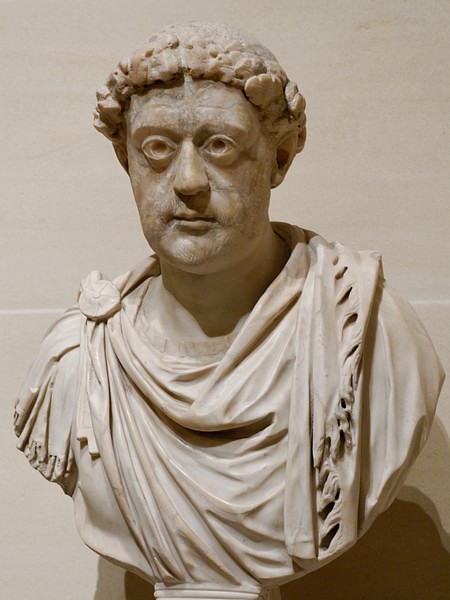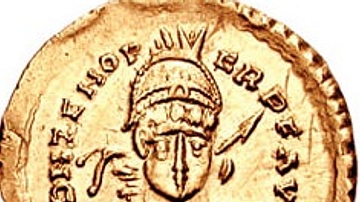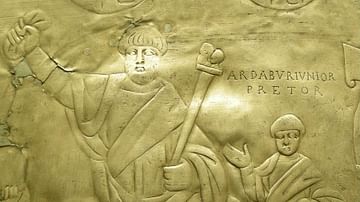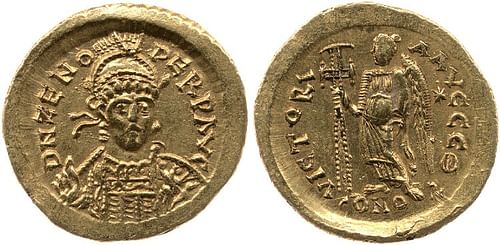
Zeno was Byzantine emperor from 474 until 491 CE. An ethnic Isaurian, Zeno was repeatedly criticized as an outsider during his reign, which was full of rebellions and attacks by the Ostrogoths. He is best known for his failed attempt to compromise between Chalcedonian Christians and the Monophysite Christians, the Henotikon, which led to the Acacian Schism with Rome, and for sending Theodoric the Great to conquer Italy.
RISE TO POWER
Zeno came from Isauria in what is today southern Turkey. His birth name was Tarasicodissa Rousoumbladotes, but he later changed it to Zeno to seem more Hellenized and to honor a general of the same name, also of Isaurian descent, who had served under Theodosius II (r. 408-450 CE). Zeno grew up to be a leading Isaurian chieftain, and he eventually attracted the attention of Leo I (r. 457-474 CE) when he reported a treacherous plot between the Persians and Ardaburius, the son of Aspar, a Germanic warlord who had made Leo emperor and wielded immense power in the Byzantine Empire. Leo appointed Zeno Count of the Domestics to reward him for his loyalty, and his influence only rose from there. Especially helpful for Leo was the fact that Isauria, Zeno's homeland, was a mountainous country and bred tough men, ideal soldiers for Leo to counter the influence of Aspar.
Zeno continued to rise in influence, becoming consul and master of soldiers for Thrace. Zeno then married Ariadne, the daughter of Leo I. The mere fact that the emperor would marry his daughter to an Isaurian shows the amount of support and value Leo placed on Isaurian power, and, more specifically, Zeno. Roman and Byzantine emperors rarely married their children to foreign peoples, especially before the 12th century. In all cases where such marriages did occur, there was a significant benefit for the emperor. Most often the benefit was strategic or military-based.
Under pressure from Aspar, Leo also had to marry his other daughter, Leontia, to Aspar's younger son, Patricius. But Leo bided his time, appointed Zeno master of the soldiers for the East, and let popular hatred against Aspar rise. With the help of the Isaurian troops and Zeno, Leo had Aspar killed and greatly reduced Germanic influence in the Byzantine Empire.
EMPEROR & REVOLT
Leo II (r. 474 CE), the half-Isaurian grandson of Leo I by Zeno and Ariadne, became emperor after Leo I's death. It is unclear whether this decision was dictated by deference to dynastic principles or lack of support for Zeno being crowned emperor. Irrespective of Leo I's reasons for crowning his seven-year-old grandson rather than his mature son-in-law, Zeno soon took power anyway. The Senate in Constantinople appointed Zeno as emperor along with his son, due to his son's young age and obvious inability to govern. Zeno then succeeded Leo as sole emperor when he died a few months later.
Zeno was not secure on the Byzantine throne for long. His mother-in-law, Leo I's widow Verina, and her brother Basiliscus joined together with a disgruntled Isaurian general named Illus to plot against Zeno. Zeno heard of the plot and fled to his homeland, leaving Constantinople to Basiliscus in early 475 CE. Basiliscus turned out to be a terrible emperor and a Monophysite, a religious doctrine declared heretical. He allied himself with Theodoric Strabo, the chieftain of the Ostrogoths, and let Germanic influence grow once again. Zeno convinced Illus to switch sides after Basiliscus massacred Isaurians in Constantinople, and the people turned against Basiliscus. When Zeno marched on Constantinople in 476 CE, he was practically unopposed and reclaimed the throne from which he had never quite been deposed. He then let Basiliscus starve to death and removed Strabo from office, reducing Ostrogothic influence at court.
RELIGIOUS POLICY
Zeno became Byzantine emperor only two decades after the Fourth Ecumenical Council of Chalcedon, which split the orthodox Christians who followed the Council of Chalcedon's ruling on Christ's nature and the Monophysites who thought differently. The Council of Chalcedon decided that Christ had two distinct natures and wills, one human and one divine, perfectly united in hypostasis with neither being superior or inferior. This decision provoked much resentment in the eastern provinces of the Byzantine Empire, where many locals believed in the Christological position of Monophysitism. Monophysites believed that Christ has one nature in which divinity and humanity are perfectly united.
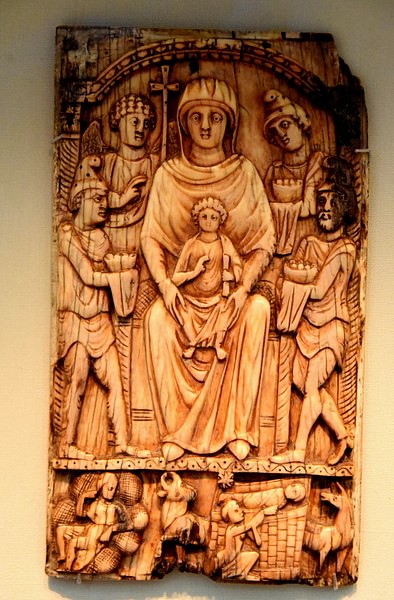
To heal this rift, Zeno encouraged Acacius, the Patriarch of Constantinople, to release the Henotikon in 482 CE. It was an attempted compromise that would have united the Chalcedonian orthodox and the dissenting Monophysites. The Henotikon affirmed several of the rulings of the Council of Chalcedon, including the condemnation of Nestorius and Eutyches and the affirmation of the Twelve Anathemas of Cyril. However, it avoided the most important Christological issue of the day: whether Christ had one or two natures. Although the Henotikon provided a basic definition of Christ's nature, it did not offer a firm stance on either side of the issue. Although there was some initial support, at least in Alexandria, Egypt, this evasive definition ultimately pleased neither side, and the definition was deemed inadequate.
Pope Felix III (483-492 CE) condemned the Henotikon and deposed Acacius, the Patriarch of Constantinople. The resulting Acacian Schism split the churches for the next three decades until the reign of Justin I (r. 518-527 CE).
PERSONALITY
We suffer from a lack of primary sources during Zeno's reign, but we can still gain a partial impression of the emperor. The 6th-century CE churchman Evagrius considered Zeno a coward who was overly interested in pleasure and debauchery. However, the Life of Daniel the Stylite, a biography of the contemporary saint, described Zeno as a pious and successful ruler. Looking at both of these sources provides a mixed view of Zeno, one that shows that Zeno's reign was certainly controversial and he was not a popular emperor.
A notable example is the Henotikon, which Zeno promulgated to end a controversy but became one itself. Zeno had a tortured relationship with Verina, his mother-in-law and widow of Leo I, and both carried out vicious plots against the other. His many plots illustrated a penchant for avarice and deceit. Zeno was also from the foreign, semi-barbarian Isaurians, arousing apprehension in the general Byzantine populace. The fragments of other remaining contemporary sources that exist today, such as the extremely anti-Zeno Malchus and the Isaurian pro-Zeno Candidus only exacerbate this view of Zeno as a controversial emperor. At the very least, Zeno was a survivor, managing to cling to power despite a slew of rebellions.
LATER REIGN
Perhaps the largest event of Zeno's reign was completely out of his control: the fall of the Western Roman Empire in 476 CE, which happened just a month after Zeno regained the throne from Basiliscus. The Germanic warlord Odoacer deposed the last Western Roman emperor, Romulus Augustulus (r. 475-476 CE), and sent the imperial regalia to Zeno in Constantinople with an offer to be Zeno's representative in Italy. Zeno was faced with offers from Odoacer and a deposed Western Roman emperor, Julius Nepos (r. 474-475 CE), requesting Zeno's recognition. Zeno asked Odoacer to recognize Nepos in Italy, but Zeno really took no action in Italy, allowing Odoacer de facto recognition as ruler of Italy.
Many barbarians led incursions into the Byzantine Empire during Zeno's reign, and their success increased through Zeno's impotence. Zeno's Isaurian troops had broken the power of Aspar during the reign of Leo I, but the Ostrogoths under Theodoric Strabo were a serious threat to the Balkans. Zeno supported a rival Ostrogothic chieftain, Theodoric the Amal, later known as “the Great.” Theodoric's Ostrogoths lived in the core Byzantine lands of Macedonia, but Zeno convinced them to move further north into Moesia and further away from Constantinople. However, over the course of Zeno's reign, his relations with the two Theodorics constantly shifted, and he played the risky game of playing the two against each other.
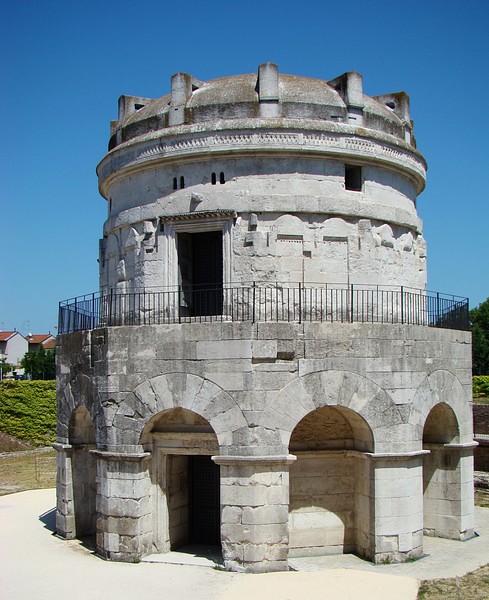
The general theme of Zeno's reign was unrest, both through barbarian incursions and internal rebellions. There was an internal rebellion by Marcian, grandson and namesake of Leo I's predecessor, Marcian (r. 450-457 CE) and son of the Western Roman emperor Anthemius (r. 467-472 CE), against Zeno in 479 CE. Marcian was defeated, but then Theodoric Strabo marched on Constantinople itself and was only foiled by the quick action of Illus manning the walls. In his retreat, Theodoric Strabo was mortally wounded after he was thrown onto a spear by his horse.
Zeno could no longer play the Ostrogoths against each other now that Theodoric Strabo was dead. After Strabo's death, Theodoric united both bands of Ostrogoths and ravaged the Balkans yet again, but Zeno successfully managed to use the Ostrogoths for his own ends. Zeno appointed Theodoric as master of the soldiers in the Emperor's presence once again and even appointing him consul for 484 CE.
The second most important rebellion of Zeno's reign, after that of Basiliscus, was a rebellion by Illus. Ariadne, Zeno's wife, despised Illus and tried to have him killed before Zeno reassigned him as master of the soldiers for the East. Zeno's relationship with Illus was a rocky one, but Illus had been invaluable in supporting Zeno against the previous rebellions by Basiliscus and Marcian. However, Ariadne's, and later Zeno's plots against Illus drove him into rebellion around 484 CE. Taking advantage of Zeno's unpopularity stemming from the Henotikon, Illus revolted in Asia Minor. He had Verina, who was his captive in Isauria, proclaim the Isaurian general Leontius as emperor. Zeno had his general John the Scythian lead a combined Byzantine-Ostrogoth force, with Theodoric's support, against Illus and Leontius, which crushed them.
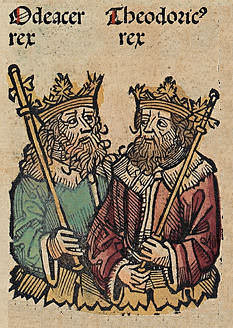
Illus had also received some support from Odoacer, who annexed Dalmatia after the death of Julius Nepos, the ex-Western Roman emperor. Meanwhile, Theodoric was an erstwhile and dangerous ally for Zeno in the Balkans. To get rid of two birds with one stone, Zeno had the daring idea of sending Theodoric to Italy and allowing him to rule in Zeno's name. After all, Zeno had never officially recognized Odoacer, the conqueror of Romulus Augustulus, the last Western Roman emperor. Theodoric marched into Italy in 488 CE, fought with Odoacer's forces until 493 CE, and agreed on co-rulership of Italy only to kill Odoacer at a dinner shortly thereafter. Theodoric then claimed Italy as a representative of the Byzantine Empire, at least originally. In time these conquests, potentially initiated on the orders of Zeno, developed into the powerful Ostrogoth Kingdom and Theodoric is remembered by history as Theodoric the Great, one of the greatest barbarian kings.
LEGACY
When Zeno's son, Zeno the Younger, died in 491 CE, the future of the throne was thrown into uncertainty. Zeno himself died shortly thereafter. Meanwhile, other sections of Byzantine society viewed and resented the Isaurians as distinct. The Isaurian sense of privilege during and after Zeno's reign follows the same trend as that of northern barbarian elements during the apogee of Aspar's power and influence. Ariadne married an imperial chamberlain, Anastasius I, who came from Greek-speaking Dyrrhachium. A general impression of the Isaurian era is that the Roman people had suffered under the rule of Zeno and the influence of the Isaurians, since the decapitated heads of Isaurians after their revolt against Anastasius I (r. 491-518 CE) were seen as “a pleasing sight for the Byzantines in return for the troubles they had suffered from Zeno and the Isaurians" (Evagrius Scholasticus, 180). Yet at the very least Zeno had cleared the Balkans of the Germanic tribes, which would be crucial for establishing peace in that region during the reigns of his successors.
